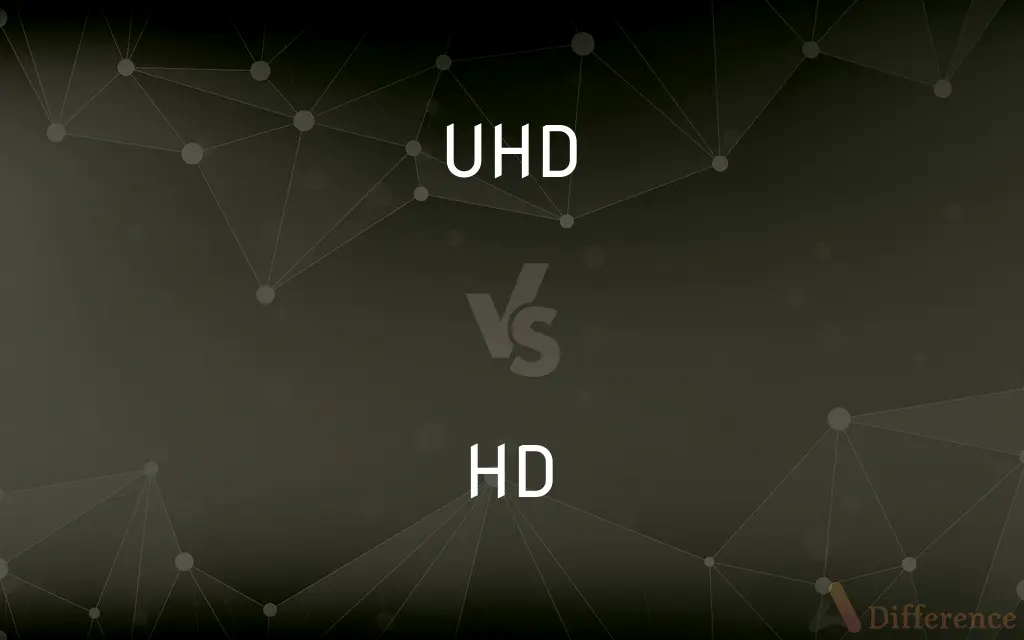UHD vs. HD — What's the Difference?
By Tayyaba Rehman & Fiza Rafique — Published on February 4, 2024
UHD, or Ultra High Definition, offers a resolution of 3840x2160 or higher, while HD, or High Definition, typically refers to 1280x720 or 1920x1080 resolution.

Difference Between UHD and HD
Table of Contents
ADVERTISEMENT
Key Differences
UHD stands for Ultra High Definition, generally featuring a resolution of 3840x2160 pixels, also known as 4K. In contrast, HD, or High Definition, typically refers to a resolution of either 1280x720 (720p) or 1920x1080 (1080p). This difference in pixel count results in UHD providing a clearer, more detailed picture compared to HD.
In UHD displays, the pixel density is significantly higher than in HD displays. This means that UHD screens can display more detailed images and are particularly beneficial for larger screens where pixelation on HD can become noticeable.
UHD content is increasingly becoming more available, but HD still has a broader range of content available. This is due to the longer presence of HD in the market and the ease of producing HD content compared to the more resource-intensive UHD content.
UHD technology tends to be more expensive than HD, reflecting the advanced technology and higher resolution. However, as UHD becomes more mainstream, its price is gradually decreasing, making it more accessible to consumers.
UHD is often considered more "future-proof" than HD. As technology progresses and the demand for higher resolution content increases, UHD is better equipped to meet these evolving demands compared to HD.
ADVERTISEMENT
Comparison Chart
Resolution
3840x2160 pixels or higher (4K, 8K)
1280x720 pixels (720p), 1920x1080 pixels (1080p)
Pixel Density
Higher, offering more detailed images
Lower, less detailed compared to UHD
Content Availability
Increasing, but less than HD
More extensive due to longer presence in the market
Price
Generally higher, reflecting newer technology
More affordable, due to longer market presence
Future Proofing
Better equipped for future demands in resolution
Less equipped compared to UHD
Compare with Definitions
UHD
UHD refers to Ultra High Definition, a resolution standard in digital cinematography and television.
The latest movie was released in UHD, offering an incredibly detailed viewing experience.
HD
HD is a common standard for television broadcasts, streaming, and Blu-ray.
Most channels now broadcast in HD, providing viewers with high-quality picture.
UHD
UHD is used to describe digital displays and content with significantly higher resolution than standard HD.
To fully appreciate the graphics of the latest video game, you should play it on a UHD screen.
HD
HD typically refers to resolutions of 1280x720 or 1920x1080 pixels, offering clearer images.
My HD television significantly improved my movie-watching experience.
UHD
UHD encompasses a range of higher resolutions including 4K and 8K, offering superior picture quality.
When I upgraded to a UHD monitor, the difference in image sharpness was immediately noticeable.
HD
HD offers a significant improvement in image quality over older standard definition formats.
Upgrading to an HD camera dramatically improved the quality of my YouTube videos.
UHD
UHD is an advanced technology in visual media, emphasizing detailed and crisp images.
Filmmakers are increasingly shooting films in UHD to capture more detailed visual expressions.
HD
HD is characterized by its ability to display more detailed and less pixelated images.
The HD resolution of the video game made the graphics look much more realistic.
UHD
UHD signifies a resolution of at least 3840x2160 pixels, often associated with 4K resolution.
My new UHD TV makes the textures in nature documentaries look incredibly lifelike.
HD
HD stands for High Definition, a digital video format with higher resolution than standard definition.
Watching sports in HD makes you feel like you're right there in the stadium.
Common Curiosities
What does UHD stand for?
UHD stands for Ultra High Definition, a resolution higher than traditional high definition.
Is UHD the same as 4K?
UHD is often associated with 4K, which is a resolution of 3840x2160 pixels.
Is UHD content widely available?
UHD content is becoming more available but is still less common than HD.
Can you notice the difference between HD and UHD?
The difference is more noticeable on larger screens, where UHD provides clearer, more detailed images.
Do I need a UHD TV to watch UHD content?
To fully experience UHD content, a UHD-compatible device is required.
What are the benefits of watching content in HD?
HD provides a clearer and more detailed picture than standard definition, enhancing the viewing experience.
Are HD and UHD compatible with each other?
UHD devices can display HD content, but HD devices cannot upscale to UHD quality.
How does screen size affect the choice between HD and UHD?
Larger screens benefit more from UHD, as the increased resolution reduces pixelation.
Can I stream in UHD on standard internet speeds?
UHD streaming requires higher internet speeds compared to HD due to larger file sizes.
What type of content is best for UHD?
High-detail content like nature documentaries and high-end video games benefit most from UHD.
What resolution is considered HD?
HD, or High Definition, typically refers to 1280x720 (720p) or 1920x1080 (1080p) resolution.
Will HD become obsolete with the rise of UHD?
While UHD is gaining popularity, HD is still widely used and will remain relevant for the foreseeable future.
Are UHD devices more expensive than HD?
UHD devices tend to be more expensive due to their higher resolution and advanced technology.
Are all new TVs UHD?
Many new TVs are UHD, but HD models are still available and common.
Is there a significant price difference between HD and UHD content?
UHD content can be more expensive due to its higher quality and production costs.
Share Your Discovery

Previous Comparison
VB vs. VB.NET
Next Comparison
Class in C++ vs. Structure in C++Author Spotlight
Written by
Tayyaba RehmanTayyaba Rehman is a distinguished writer, currently serving as a primary contributor to askdifference.com. As a researcher in semantics and etymology, Tayyaba's passion for the complexity of languages and their distinctions has found a perfect home on the platform. Tayyaba delves into the intricacies of language, distinguishing between commonly confused words and phrases, thereby providing clarity for readers worldwide.
Co-written by
Fiza RafiqueFiza Rafique is a skilled content writer at AskDifference.com, where she meticulously refines and enhances written pieces. Drawing from her vast editorial expertise, Fiza ensures clarity, accuracy, and precision in every article. Passionate about language, she continually seeks to elevate the quality of content for readers worldwide.













































